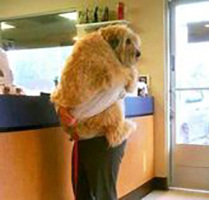 It’s not uncommon to sit in a veterinarian’s office and see dog after dog walk happily up to the door then stop to a screeching halt as the pet parent attempts to gracefully scoot their dog through the door. For most of us, it’s also easy to recall small dogs in carriers or on their pet parent’s lap shivering and panting in fear in the waiting room of the vet’s offices and grooming facilities. We routinely see dogs afraid to take a bath, get their nails trimmed, be groomed, or be restrained and handled that we think it’s perfectly normal. We compare it to the unpleasant anticipation of going to the dentist or doing our taxes — it’s something we hate to do, but it has to be done. Isn’t the same true for our dogs?
It’s not uncommon to sit in a veterinarian’s office and see dog after dog walk happily up to the door then stop to a screeching halt as the pet parent attempts to gracefully scoot their dog through the door. For most of us, it’s also easy to recall small dogs in carriers or on their pet parent’s lap shivering and panting in fear in the waiting room of the vet’s offices and grooming facilities. We routinely see dogs afraid to take a bath, get their nails trimmed, be groomed, or be restrained and handled that we think it’s perfectly normal. We compare it to the unpleasant anticipation of going to the dentist or doing our taxes — it’s something we hate to do, but it has to be done. Isn’t the same true for our dogs?

The difference between what we experience when we do something we don’t like and what our dogs experience when they do something they don’t like is in fact very different. We know the reason we are doing it, and it is usually for some greater good. It may be something we don’t enjoy, but we still fully choose whether or not to participate. Our dogs don’t have that luxury. We restrain them against their will, and if they run away from the situation, we chase them down and the struggle continues. Our dogs don’t merely dislike these things, they are fearful and it causes great psychological and physiological stress. Their body releases cortisol which causes adrenaline to pump throughout their system, thus leaving them in full flight or fight mode. We know what we’re putting our dogs through is for the benefit of their health and well-being, but all they know is it is painful or scary and they just want to feel safe.


I had a childhood experience that helped me better understand what our pets go through when we restrain and handle them with force. When I was 10 years old I contracted the flu and became so ill that I had to be hospitalized. I was in the intensive care unit and on a ventilator for 3 weeks. During that time the nurses and doctors would come in, and while some were nice, others seemed rushed and quickly finished their tasks. My blood was taken daily, the IV was moved every few days, and other procedures were done regularly–all this frightened me as a child. Because I was on a ventilator, I couldn’t speak. I didn’t always understand what they were doing and why they were doing it and I couldn’t ask them to stop when I couldn’t handle it anymore. I couldn’t tell them it hurt. I couldn’t ask them to go slower so I could mentally deal with the procedures. I developed anxiety about everything, and with my voice taken away all that was left was aggression when I couldn’t take anymore. Of course I was too ill to use aggression as a tool to make the nurses and doctors stop prodding, but it was certainly the only thing left I could have used to communicate my fear. Though the hospital staff did what they had to do to get me well again and I was ever so blessed to have survived, this ordeal has left a lasting impression on me. Through it, I have a greater understanding of what animals experience and has been helpful in understanding and relating to pets so that I could later help reduce stress in the lives of animals. I am grateful to have endured such an experience for this reason.


Join Our Expert Dog Trainer Sessions Today
Ready to witness remarkable transformations in your dog’s behavior? Join us on this journey of positive reinforcement and effective training. Let’s create a lasting bond with your furry companion – sign up for a session now and experience the joy of a well-trained, happy dog!


